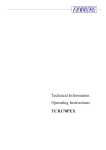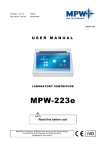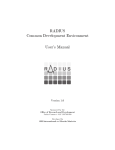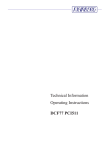Download Meinberg GPS164/AQ/xHS Technical information
Transcript
Technical Information Operating Instructions GPS164xHS GPS164/AQ/xHS Contact Information Meinberg Funkuhren GmbH & Co. KG Lange Wand 9 D-31812 Bad Pyrmont Telefon: ++49 (0) 52 81 / 9309-0 Telefax: ++49 (0) 52 81 / 9309-30 Internet: http://www.meinberg.de Email: [email protected] December 16th, 2009 Table of contents Contact Information............................................................................. 2 Content of the USB stick ..................................................................... 4 General information............................................................................. 5 Block diagram GPS164xHS................................................................. 6 GPS164xHS features............................................................................ 7 Time zone and daylight saving .................................................. 7 Pulse outputs .............................................................................. 8 Asynchronous serial ports .......................................................... 9 Time code outputs ...................................................................... 9 Introduction ....................................................................... 9 Available time codes ...................................................... 10 Code generation .............................................................. 10 IRIG standard format ...................................................... 11 AFNOR time code format ............................................... 12 Assignment of CF Segment in IEEE1344 mode ............ 13 DCF77 emulation ..................................................................... 14 Installation ......................................................................................... 15 Power supply ............................................................................ 15 Mounting the antenna ............................................................... 16 Powering up the system ........................................................... 16 The front panel layout........................................................................ 17 FAIL LED ................................................................................. 17 LOCK LED ............................................................................... 17 OCx LEDs ................................................................................. 17 BSL Key ................................................................................... 17 BNC connector DCF Out .......................................................... 18 Connectors TC_Out ( AM / DCLS ) ........................................ 18 BNC connector GPS Ant .......................................................... 18 Assignment of the terminal block ............................................ 18 Assignment of the DSUB connectors ...................................... 19 Replacing the lithium battery ............................................................ 19 CE label .............................................................................................. 19 Technical specifications GPS164xHS ............................................... 20 Front views ............................................................................... 23 Technical specifications of antenna ......................................... 24 Assembly with CN-UB/E (CN-UB-280DC) ............................ 25 Format of the Meinberg standard time string .......................... 26 Format of the SAT time string ................................................. 27 Format of the time string Uni Erlangen (NTP) ....................... 28 Format of the NMEA (RMC) string ........................................ 30 Format of the Computime Time String .......................... 31 The program GPSMON32 ................................................................. 32 Online Help .............................................................................. 33 Content of the USB stick Besides this manual, the provided USB stick includes a setup program for the monitor software GPSMON32. This utility can be used to configure Meinberg GPS receivers via their serial ports and display status information of the module. The software is executable under the following operating systems: - Windows Server 2003 Windows XP Windows 2000 Windows NT Windows ME Windows 9x If the USB stick is lost, the setup program can be downloaded for free at: http://www.meinberg.de/english/sw/#gpsmon 4 General information The Meinberg satellite receiver clocks of the GPS164xHS series are available with several options. This manual describes the following models: GPS164DHS GPS164AHS GPS164DAHS GPS164/AQ/DHS GPS164/AQ/AHS GPS164/AQ/DAHS 19...72VDC 100...240VAC 100...240VDC optocoupler outputs PhotoMOS relay outputs X X X X X X X X X X X X X X The vaiants differ in power supply and the type of DC-isolation of the programmable pulse outputs. The differences are described in the relevant chapters, the name GPS164xHS is used whenever common features of all types of clocks are specified. The satellite receiver clock GPS164xHS has been designed to provide an extremly precise time reference for the generation of programmable pulses. High precision available 24 hours a day around the whole world is the main feature of the new system which receives it's information from the satellites of the Global Positioning System. The Global Positioning System (GPS) is a satellite-based radio-positioning, navigation, and time-transfer system. It was installed by the United States Departement of Defense and provides two levels of accuracy: The Standard Positioning Service (SPS) and the Precise Positioning Service (PPS). While PPS is encrypted and only available for authorized (military) users, SPS has been made available to the general public. GPS is based on accurately measuring the propagation time of signals transmitted from satellites to the user´s receiver. A nominal constellation of 21 satellites together with 3 active spares in six orbital planes 20000 km over ground provides a minimum of four satellites to be in view 24 hours a day at every point of the globe. Four satellites need to be received simultaneously if both receiver position (x, y, z) and receiver clock offset from GPS system time must be computed. All the satellites are monitored by control stations which determine the exact orbit parameters as well as the clock offset of the satellites´ on-board atomic clocks. These parameters are uploaded to the satellites and become part of a navigation message which is retransmitted by the satellites in order to pass that information to the user´s receiver. The high precision orbit parameters of a satellite are called ephemeris parameters whereas a reduced precision subset of the ephemeris parameters is called a satellite´s almanac. While ephemeris parameters must be evaluated to compute the receiver´s position and clock offset, almanac parameters are used to check which satellites are in view from a given receiver position at a given time. Each satellite transmits its own set of ephemeris parameters and almanac parameters of all existing satellites. 5 Block diagram GPS164xHS 6 GPS164xHS features The GPS164xHS is designed for mounting on a DIN rail. The front panel integrates five LED indicators, a hidden push button, an eight-pole terminal block, theree DSUB- and three BNC-connectors. The receiver is connected to the antenna/converter unit by a 50 Ω-coaxial cable with length up to 300 m (when using RG58 cable). It is possible to connect up to four receivers to one antenna by using an optional antenna diplexer. The navigation message coming from the satellites is decoded by GPS164xHS´s microprocessor in order to track the GPS system time with an accuracy of better than ±250 nsec. Compensation of the RF signal´s propagation delay is done by automatical determination of the receiver´s position on the globe. A correction value computed from the satellites´ navigation messages increases the accuracy of the board´s TCXO to ±5.10-9 and automatically compensates the oscillators aging. The last recent value is restored from the battery buffered memory at power-up. Time zone and daylight saving GPS system time differs from the universal time scale (UTC) by the number of leap seconds which have been inserted into the UTC time scale after GPS has been initiated in 1980. The current number of leap seconds is part of the navigation message supplied by the satellites, so GPS164xHS´s internal real time is based on UTC. Conversion to local time including handling of daylight saving year by year can be done by the receiver´s microprocessor if the corresponding parameters are set up with the help of the software GPSMON32 (included Windows software). 7 Pulse outputs The pulse generator of the satellite controlled clock GPS164xHS containes three independant channels and is able to generate a multitude of different pulses, which are configured with the software GPSMON32. The active state of each channel is invertible, the pulse duration settable between 10 msec and 10 sec in steps of 10 msec. In the default mode of operation the pulse outputs are disabled until the receiver has synchronized after power-up. However, the system can be configured to enable those outputs immediately after power-up. The pulse outputs are electrically insulated by optocouplers (GPS164xHS) or PhotoMOS relays (GPS164/AQ/xHS) and are available at the terminal block. The following modes can be configured for each channel independently: Timer mode: Three on- and off-times per day per channel programmable Cyclic mode: Generation of periodically repeated pulses. A cycle time of two seconds would generate a pulse at 0:00:00, 0:00:02, 0:00:04 etc. DCF77-Simulation mode: The corresponding output simulates the DCF77 time telegram. The time marks are representing the local time as configured by the user. Single Shot Mode: A single pulse of programmable length is generated once a day at a programmable point of time Per Sec. Per Min. Per Hr. modes: Pulses each second, minute or hour Status: One of three status messages can be emitted: ‘position OK’: The output is switched on if the receiver was able to compute its position ‘time sync’: The output is switched on if the internal timing is synchronous to the GPS-system ‘all sync’: Logical AND of the above status messages. The output is active if position is calculated AND the timing is synchronized Time code: The un-modulated IRIG or AFNOR signal of the built in time code generator is made available at the respective output. Time string: The time string of the serial port COM1 is made available at the respective output. Idle-mode: The output is inactive 8 Asynchronous serial ports Two asynchronous serial interfaces (RS-232) called COM0 and COM1 are available to the user. In the default mode of operation, the serial outputs are disabled until the receiver has synchronized after power-up. However, the system can be configured to enable those outputs immediately after power-up. Transmission speeds, framings and the kind of the time string can be configured separately. The serial ports are sending a time string either once per second, once per minute or on request with ASCII ´?´ only. The format of the output strings is ASCII, see the technical specifications for details. The corresponding parameters can be set up by GPSMON32 (included Windows software) using serial port COM0. Optionally serial port COM1 can be delivered as an RS-485 interface. Time code outputs Introduction The transmission of coded timing signals began to take on widespread importance in the early 1950´s. Especially the US missile and space programs were the forces behind the development of these time codes, which were used for the correlation of data. The definition of time code formats was completely arbitrary and left to the individual ideas of each design engineer. Hundreds of different time codes were formed, some of them were standardized by the "Inter Range Instrumantation Group" (IRIG) in the early 60´s. Detailed information about IRIG and other time codes can be found on http://www.meinberg.de/english/info/irig.htm Except these time codes other formats, like NASA36, XR3 or 2137, are still in use. The module GPS164TDHS however generates IRIG-B or AFNOR NFS-500 only. Selection of the generated time code is done by using the monitor program GPSMON32. 9 Available time codes The time code generator of the module GPS164xHS is able to generate the timecodes shown below. The modulated codes (IRIG B122/B123, AFNOR, IEEE1344) are available via the BNC-connector, the unmodulated codes (IRIG B002/B003 and IEEE1344) via a DSUB connector in the front panel. The unmodulated codes are available as a transistor output with internal pull up (470 Ω to +5V), with TTL-level into 50 Ω and with RS422 level. B002: 100pps, DC Level Shift pulse width coded, no carrier BCD time of year B122: 100pps, amplitude modulated sine wave signal, 1 kHz carrier frequency BCD time of year B003: 100pps,DC Level Shift pulse width coded, no carrier BCD time of year, SBS time of day B123: 100pps, amplitude modulated sine wave signal, 1 kHz carrier frequency BCD time of year, SBS time of day AFNOR: 100pps, amplitude modulated sine wave signal, 1 kHz carrier frequency BCD time of year, complete date, SBS time of day output level adapted IEEE1344: Code according to IEEE1344-1995 100pps, AM-Sine wave signal, 1kHz carrier frequency, BCD-time of year, SBS time of day IEEE1344 extensions for: date, timezone, daylight-saving and leap second in control functions ( CF ) segment. also see table ‘Assignment of CF segment in IEEE1344 mode’ Code generation In the default mode of operation the IRIG/AFNOR ti mecode outputs are disabled until the GPS-receiver has been synchronized after power-up. The generation of the IRIG-code only starts after synchronization therefore. If the code must be available immediately after power-up, the software GPSMON32 can be used to enable the time code output without synchronization of the GPS-receiver by setting the enable flag 'pulses' to 'always'. In this mode of operation the IRIG-code is not locked to UTC-second until synchronization. 10 IRIG standard format 11 AFNOR time code format 12 Assignment of CF Segment in IEEE1344 mode Bit No. De signation De scription 49 Position Identif ier P5 50 Year BCD encoded 1 51 Year BCD encoded 2 52 Year BCD encoded 4 53 Year BCD encoded 8 54 empty, always zero 55 Year BCD encoded 10 56 Year BCD encoded 20 57 Year BCD encoded 40 58 Year BCD encoded 80 59 Position Identifier P6 60 LSP - Leap Second Pending set up to 59s before LS insertion 61 LS - Leap Second 1.) 62 DSP - Daylight Saving Pending set up to 59s before daylight saving changeover 63 DST - Daylight Saving Time set during daylight saving time 64 Timezone Offset Sign sign of TZ offset 0 = '+', 1 = '-' 65 TZ Offset binary encoded 1 66 TZ Offset binary encoded 2 67 TZ Offset binary encoded 4 68 TZ Offset binary encoded 8 69 Position Identifier P7 70 TZ Offset 0.5 hour 71 TFOM Time figure of merit 72 TFOM Time figure of merit 73 TFOM Time figure of merit 74 TFOM Time figure of merit 75 PARITY low nibble of BCD encoded year high nibble of BCD encoded year 0 = add leap second, 1 = delete leap second Offset from IRIG time to UTC time. Encoded IRIG time plus TZ Offset equals UTC at all times ! set if additional half hour offset time figure of merit represents approximated clock error. 2.) 0x00 = clock locked 0x0F = clock failed parity on all preceding bits incl. IRIG-B time 1.) current firmware does not support deletion of leap seconds 2.) TFOM is cleared, when clock is synchronized first after power up. see chapter Selection of generated timecode 13 DCF77 emulation The GPS164xHS satellite controlled clock generates time marks which are compatible with the time marks spread by the German long wave transmitter DCF77. If configured in GPSMON32, these time marks are available as pulse outputs. In addition, an AM-modulated carrier frequency of 77.5kHz is available via a BNCconnector in the front panel. This signal can be used as a replacement for a DCF77antenna. The long wave transmitter installed in Mainflingen near Frankfurt/Germany transmits the reference time of the Federal Republic of Germany: time of day, date of month and day of week in BCD coded second pulses. Once every minute the complete time information is transmitted. However, GPS164xHS generates time marks representing its local time as configured by the user, including announcement of changes in daylight saving and announcement of leap seconds. The coding sheme is given below: Time marks start at the beginning of new second. If a binary "0" is to be transmitted, the length of the corresponding time mark is 100 msec, if a binary "1" is transmitted, the time mark has a length of 200 msec. The information on the current date and time as well as some parity and status bits can be decoded from the time marks of the 15th up to the 58th second every minute. The absence of any time mark at the 59th second of a minute signals that a new minute will begin with the next time mark. 14 Installation Power supply The variants of the module GPS164xHS are designed for following power supply options: GPS164DHS and GPS164/AQ/DHS: 19...72 VDC (DC-insulation 1.5 kVDC) GPS164AHS and GPS164/AQ/AHS: 100...240 VAC, 47...63 Hz GPS164DAHS and GPS164/AQ/DAHS : 100...240 VDC 100...240 VAC, 47...63 Hz The voltage feed of the DC variants is done via terminal blocks in the frontpanel of the clock and should have low resistance to minimize spurious emission (EMI). The AC models include a fuse which is available at the front panel. To avoid potential differences between the signal ground of GPS164xHS and a post-connected unit installed on different DIN rails, the signal ground of the clock is insulated from the case. The case must be grounded by using the rear contact. 15 Mounting the antenna The GPS satellites are not stationary but circle round the globe in a period of about 12 hours. They can only be received if no building is in the line-of-sight from the antenna to the satellite, so the antenna/converter unit must be installed in a location from which as much of the sky as possible can be seen. The best reception is given when the antenna has a free view of 8° angular elevation above horizon. If this is not possible the antenna should be installed with a mostly free view to the equator because of the satellite courses which are located between latitudes of 55° North and 55° South. If even this is not possible problems occure especially when at least four sattelites for positioning have to be found. The unit can be mounted using a pole with a diameter up to 60 mm. A standard coaxial cable with 50 Ω impedance (e.g. RG58C) should be used to connect the antenna/converter unit to the receiver. Cable thinner than RG58 should be avoided due to its higher DC resistance and RF attenuation. When using the optional antenna diplexer the total length of one antenna line between antenna, diplexer and receiver must not be longer than 300 m. If a cable with less attenuation is used its length may be increased accordingly (e.g. 600 m with RG213). Powering up the system If both, the antenna and the power supply have been connected, the system is ready to operate. About 10 seconds after power-up the receiver´s TCXO has warmed up and operates with the required accuracy. If the receiver finds valid almanac and ephemeris data in its battery buffered memory and the receiver´s position has not changed significantly since its last operation the receiver can find out which satellites are in view now. Only a single satellite needs to be received to synchronize and generate output pulses, so synchronization can be achieved maximally one minute after power-up. If the receiver position has changed by some hundred kilometers since last operation, the satellites´ real elevation and doppler might not match those values expected by the receiver thus forcing the receiver to start scanning for satellites. This mode is called Warm Boot because the receiver can obtain ID numbers of existing satellites from the valid almanac. When the receiver has found four satellites in view it can update its new position and switch to Normal Operation. If the almanac has been lost because the battery had been disconnected the receiver has to scan for a satellite and read in the current almanacs. This mode is called Cold Boot. It takes 12 minutes until the new almanac is complete and the system switches to Warm Boot mode scanning for other satellites. 16 The front panel layout FAIL LED The FAIL LED is turned on whenever the receiver is not synchronous to the GPSsystem. DCF + Oc 1 - LOCK LED The LOCK LED is turned on if the receiver has acquired at least four satellites and has computed its position after power-up. In normal operation the receiver position is updated continuously as long as at least four satellites can be received. When the receivers position is known and steady only, a single satellite needs to be received for synchronization and generatation of output pulses. + Ub - Out Lock + Oc 2 - Fail + Oc 3 - BSL COM 0 COM 1 TC_Out (DCLS) TC_Out (AM) GPS Ant. GPS164DHS OCx LEDs The LEDs OC1, OC2 and OC3 are indicating the status of the corresponding pulse output. A burning LED symbolizes the ON-state of an optocoupler. BSL Key Whenever the on-board software must be upgraded or modified, the new firmware can be downloaded to the internal flash memory using the serial port COM0. There is no need to open the metal case and insert a new EPROM. If the BSL key behind the front panel is pressed during operation, a bootstraploader is actived and waits for instructions from the serial port COM0. The new firmware can be sent to GPS164xHS from any standard PC with serial interface. A loader program will be shipped together with the file containing the image of the new firmware. The contents of the program memory will not be modified until the loader program has sent the command to erase the flash memory. So, if the BSL key is pressed unintentionally, the firmware will not be changed accidentially. After the next power-up, the system will be ready to operate again. 17 BNC connector DCF Out The insulated AM-modulated carrier frequency is available using this connector. Connectors TC_Out ( AM / DCLS ) The modulated IRIG or AFNOR ti mecode signal is output at the BNC connector TC_Out ( AM ), the un-modulated time code signal is available at Sub-D Connector TC_Out ( DCLS ) BNC connector GPS Ant The antenna/converter unit is connected to the receiver circuit of the GPS164xHS through this connector. Assignment of the terminal block The pulse outputs are accessible through the terminal block in the front panel. In addition, the power supply of variants GPS164DHS and GPS164/AQ/DHA is connected using two poles of this terminal block. The marking besides the terminal has the following meaning: Standard Option PhotoMOS relays +Ub -Ub positive potential of power supply (GPS164(/AQ/)DHS only) reference potential of power supply (GPS164(/AQ/)DHS only) +OCx -OCx collector of optocoupler emitter of optocoupler PMRx_1 PMRx_2 contact 1 of PhotoMOS relay contact 2 of PhotoMOS relay 18 Assignment of the DSUB connectors The serial ports COM0 and COM1 as well as the unmodulated IRIG/AFNOR time code signals are accessible via nine-pole DSUB connectors in the frontpanel. These RS-232 interfaces can be connected to a computer by using a standard modem cable. TxD describes the sending, RxD the receiving line of the GPS164xHS. Replacing the lithium battery The life time of the lithium battery on the board is at least 10 years. If the need arises to replace the battery, the following should be noted: ATTENTION! Danger of explosion in case of inadequate replacement of the lithium battery. Only identical batteries or batteries recommended by the manufacturer must be used for replacement. The waste battery must be disposed as proposed by the manufacturer of the battery. CE label 19 Technical specifications GPS164xHS RECEIVER: 6 channel C/A code receiver with external antenna/converter unit ANTENNA: Antenna/converter unit with remote power supply refer to chapter "Technical specifications of antenna" ANTENNA INPUT: Antenna circuit dc-insulated; dielectric strength: 1000V Length of cable: refer to chapter "Mounting the antenna" TIME TO SYNCHRONIZATION: one minute with known receiver position and valid almanac 12 minutes if invalid battery buffered memory BATTERY BACKUP: PULSE OUTPUTS: storage of pulse configuration and important GPS-system data in the internal RAM, backed-up by lithium battery lifetime of battery 10 years min. three programmable outputs GPS164DHS, GPS164AHS, GPS164DAHS DC-insulated by optocouplers UCEmax = 55 V, ICmax = 50 mA, Ptot = 150 mW, Viso = 5000 V pulse delay: t on e.g. 20 µsec (IC = 10 mA) toff e.g. 3 µsec (IC = 10mA) GPS164/AQ/DHS, GPS164/AQ/AHS, GPS164/AQ/DAHS DC-insulated by PhotoMOS relays Umax = 400 V, Imax = 150 mA, Ptot = 360 mW, Viso = 1500 V pulse delay: t on e.g. 0,18 msec (Iload = 150 mA) toff e.g. 0,07 msec (Iload = 150mA) default settings: ACCURACY OF PULSES: all pulse outputs inactive mode of operation: 'if sync' better than ±250nsec after synchronization and 20 minutes of operation better than ±3 µsec during the first 20 minutes of operation 20 SERIAL PORTS: 2 independant asynchronous serial ports COM0 (RS-232) Baud Rate: 300 up to 19200 Framing: 7N2, 7E1, 7E2, 8N1, 8N2, 8E1 COM1 (RS-232, optional RS-485) Baud Rate: 300 up to 19200 Framing: 7N2, 7E1, 7E2, 8N1, 8N2, 8E1 time string selectable for COM0 and COM1 'standard Meinberg', 'SAT', 'Uni Erlangen (NTP)', 'NMEA-183' ( RMC ), and 'Computime' default settings: TIME CODE OUTPUTS: COM0: 19200, 8N1 COM1: 9600, 8N1 'standard Meinberg' for COM0 and COM1 time string per second mode of operation 'if sync' modulated via BNC-connector: IRIG: 3VPP (MARK), 1VPP (SPACE) into 50 Ω AFNOR: 2.17VSS (MARK), 0.688VSS (SPACE) into 50 Ω modulated via DSUB-connector: Field effect transistor with internal pull-up (470 Ω) to +5V Data of transistor: Udsmax = 100 V, Idmax = 150 mA, Pmax = 250 mW TTL into 50 Ω RS422 DCF77 EMULATION: STATUS INDICATION: AM-modulated 77.5 kHz carrier frequency usable as replacement for a DCF77 antenna output level approximately -55 dBm (unmodulated) receiver status: Lock: the reciever was able to compute its position after power-up Fail: the receiver is asynchronous to the GPS-system status of the pulse outputs: a burning LED indicates the active state of the corresponding optocoupler/PhotoMOS relay 21 POWER REQUIREMENTS: GPS164DHS, GPS164/AQ/DHS 19...72 VDC DC-isolation 1.5 kVDC GPS164AHS, GPS164/AQ/AHS 100...240 VAC, 47...63 Hz fuse: 500 mA GPS164DAHS, GPS164/AQ/DAHS 100...240 VDC 100...240 VAC, 47...63 Hz fuse: 500 mA DIMENSION: GPS164DHS, GPS164/AQ/DHS 105 mm x 85 mm x 104 mm (height x width x depth) GPS164AHS, GPS164/AQ/AHS, GPS164DAHS,GPS164/AQ/DAHS 105 mm x 125.5 mm x 104 mm (height x width x depth) CONNECTORS: coaxial BNC connectors for antenna/converter unit, AMmodulated DCF77 output and modulated time code output eight-pole terminal block for connection of: - pulse outputs - power supply (GPS164DHS and GPS164/AQ/DHS only) GPS164AHS and GPS164/AQ/AHS only: power cord receptacle for AC-line GPS164DAHS and GPS164/AQ/DAHS only: three-pole terminal block for connection of power supply AMBIENT TEMPERATURE: 0 ... 50°C HUMIDITY: 85% max. 22 Front views The following figures are showing the front panels of the variants of the module GPS164xHS: Standard Option PhotoMOS relays 23 Technical specifications of antenna ANTENNA: dielectrical patch antenna, 25 x 25mm receive frequency: 1575.42 MHz bandwidth: 9 MHz CONVERTER: local oscillator to converter frequency: first IF frequency: 10 MHz 35.4 MHz POWER REQUIREMENTS: 12V ... 18V, @ 100mA (provided via antenna cable) CONNECTOR: coax type N, female AMBIENT TEMPERATURE: -25 ... +65°C HOUSING: ABS plastic case for outdoor installation (IP56) PHYSICAL DIMENSION: 24 Assembly with CN-UB/E (CN-UB-280DC) 25 Format of the Meinberg standard time string The Meinberg standard time string is a sequence of 32 ASCII characters starting with the STX (start-of-text) character and ending with the ETX (end-of-text) character. The format is: <STX>D:dd.mm.yy;T:w;U:hh.mm.ss;uvxy<ETX> The letters printed in italics are replaced by ASCII numbers whereas the other characters are part of the time string. The groups of characters as defined below: <STX> Start-Of-Text (ASCII code 02h) dd.mm.yy the current date: dd day of month (01..31) mm month (01..12) yy year of the century (00..99) w the day of the week (1..7, 1 = Monday) hh.mm.ss the current time: hh hours mm minutes ss seconds (00..23) (00..59) (00..59, or 60 while leap second) uv clock status characters: u: ‘#’ clock has not synchronized after reset ‘ ‘ (space, 20h) clock has synchronized after reset v: different for DCF77 or GPS receivers: ‘*’ DCF77 clock currently runs on XTAL GPS receiver has not checked its position ‘ ‘ (space, 20h) DCF77 clock is sync'd with transmitter GPS receiver has determined its position x time zone indicator: ‘U’ UTC Universal Time Coordinated, formerly GMT ‘ ‘ MEZ European Standard Time, daylight saving disabled ‘S’ MESZ European Summertime, daylight saving enabled y announcement of discontinuity of time, enabled during last hour before discontinuity comes in effect: ‘!’ announcement of start or end of daylight saving time ‘A’ announcement of leap second insertion ‘ ‘ (space, 20h) nothing announced <ETX> End-Of-Text (ASCII code 03h) 26 Format of the SAT time string The SAT time string is a sequence of 29 ASCII characters starting with the STX (start-of-text) character and ending with the ETX (end-of-text) character. The format is: <STX>tt.mm.jj/w/hh.mm.ssMEzzxy<CR><LF><ETX> The letters printed in italics are replaced by ASCII numbers whereas the other characters are part of the time string. The groups of characters as defined below: <STX> Start-Of-Text (ASCII code 02h) dd.mm.yy the current date: dd day of month (01..31) mm month (01..12) yy year of the century (00..99) w the day of the week (1..7, 1 = Monday) hh.mm.ss the current time: hh hours mm minutes ss seconds (00..23) (00..59) (00..59, or 60 while leap second) zz time zone indicator: ‘Z ‘ MEZ European Standard Time, daylight saving disabled ‘SZ’ MESZ European Summertime, daylight saving enabled x clock status characters: ‘*’ DCF77 clock currently runs on XTAL GPS receiver has not checked its position ‘‘ (space, 20h) DCF77 clock is sync'd with transmitter GPS receiver has determined its position y announcement of discontinuity of time, enabled during last hour before discontinuity comes in effect: ‘!’ announcement of start or end of daylight saving time ‘ ‘ (space, 20h) nothing announced <CR> Carriage return (ASCII code 0Dh) <LF> Line feed (ASCII code 0Ah) <ETX> End-Of-Text (ASCII code 03h) 27 Format of the time string Uni Erlangen (NTP) The time string Uni Erlangen (NTP) of a GPS-clock is a sequence of 66 ASCII characters starting with the STX (start-of-text) character and ending with the ETX (end-of-text) character. The format is: <STX>tt.mm.jj; w; hh:mm:ss; voo:oo; acdfg i;bbb.bbbbn lll.lllle hhhhm<ETX> The letters printed in italics are replaced by ASCII numbers whereas the other characters are part of the time string. The groups of characters as defined below: <STX> Start-Of-Text (ASCII code 02h) dd.mm.yy the current date: dd day of month (01..31) mm month (01..12) yy year of the century (00..99) w the day of the week (1..7, 1 = Monday) hh.mm.ss the current time: hh hours mm minutes ss seconds (00..23) (00..59) (00..59, or 60 while leap second) v sign of the offset of local timezone related to UTC oo:oo offset of local timezone related to UTC in hours and minutes ac clock status characters: a: ‘#’ clock has not synchronized after reset ‘ ‘ (space, 20h) clock has synchronized after reset c: ‘*’ GPS receiver has not checked its position ‘ ‘ (space, 20h) GPS receiver has determined its position d time zone indicator: ‘S’ MESZ European Summertime, daylight saving enabled ‘ ‘ MEZ European Standard Time, daylight saving disabled f announcement of discontinuity of time, enabled during last hour before discontinuity comes in effect: ‘!’ announcement of start or end of daylight saving time ‘ ‘ (space, 20h) nothing announced g announcement of discontinuity of time, enabled during last hour before discontinuity comes in effect: ‘A’ announcement of leap second insertion ‘ ‘ (space, 20h) nothing announced 28 i leap second insertion ‘L’ leap second is actually inserted (active only in 60th sec.) ‘ ‘ (space, 20h) no leap second is inserted bbb.bbbb latitude of receiver position in degrees leading signs are replaced by a space character (20h) n latitude, the following characters are possible: ‘N’ north of equator ‘S’ south of equator lll.llll longitude of receiver position in degrees leading signs are replaced by a space character (20h) e longitude, the following characters are possible: ‘E’ east of Greenwich ‘W’ west of Greenwich hhhh altitude above sea level in meters leading signs are replaced by a space character (20h) <ETX> End-Of-Text (ASCII-code 03h) 29 Format of the NMEA (RMC) string The NMEA String is a sequence of 65 ASCII characters starting with the ‘$’ character and ending with the characters CR (carriage return) and LF (line-feed). The format is: $GPRMC,hhmmss.ss,A,bbbb.bb,n,lllll.ll,e,0.0,0.0,ddmmyy,0.0,a*hh<CR><LF> The letters printed in italics are replaced by ASCII numbers or letters whereas the other characters are part of the time string. The groups of characters as defined below: $ start character (ASCII-Code 24h) hhmmss.ss the current time: hh hours mm minutes ss seconds ss fractions of seconds (00..23) (00..59) (00..59, or 60 while leap second) (1/10 ; 1/100) A Status (A = time data valid) (V = time data not valid) bbbb.bb latitude of receiver position in degrees leading signs are replaced by a space character (20h) n latitude, the following characters are possible: ‘N’ north of equator ‘S’ south d. equator lllll.ll longitude of receiver position in degrees leading signs are replaced by a space character (20h) e longitude, the following characters are possible: ‘E’ east of Greenwich ‘W’ west of Greenwich ddmmyy the current date: dd day of month (01..31) mm month (01..12) yy year of the century (00..99) a magnetic variation hh checksum (EXOR over all characters except ‘$’ and ‘*’) <CR> carriage-return; ASCII-Code 0Dh <LF> line-feed; ASCII-Code 0Ah 30 Format of the Computime Time String The Computime time string is a sequence of 24 ASCII characters starting with the T character and ending with the LF (line feed, ASCII Code 0Ah) character. The format is: T:yy:mm:dd:ww:hh:mm:ss<CR><LF> The letters printed in italics are replaced by ASCII numbers whereas the other characters are part of the time string. The groups of characters as defined below: T Start character sending with one bit occuracy at change of second yy:mm:dd the current date: yy year of the century (00..99) mm month (01..12) dd day of month (01..31) ww the day of the week (01..07, 01 = monday) hh:mm:ss the current time: hh hours mm minutes ss seconds (00..23) (00..59) (00..59, or 60 while leap second) <CR> Carriage Return, ASCII Code 0Dh <LF> Line Feed, ASCII Code 0Ah 31 The program GPSMON32 The program GPSMON32 can be used to monitor and program all essential functions of Meinberg GPS-Receivers. The Software is executable under Win9x/2k/ NT. To install GPSMON32 just run Setup.exe from the included diskette and follow the instructions of the setup program. To obtain a connection between your PC and the GPS-receiver, connect the receivers COM0 port to a free serial port of your PC. The PCs comport used by the program GPSMON32 can be selected in submenu 'PC-Comport' in menu 'Connection'. Also transfer rate and framing used by the program are selected in this menu. Communication between the clock and the PC comes about, only if the GPS serial port is configured in the same way as the PCs comport. You can enforce an access, if the GPS serial port is not configured with appropriate parameters for communication. Select the menu item 'Enforce Connection' in menu 'Connection' and click 'Start' in the appearing window. Some firmware versions of GPS167 do not support this way of setting up a connection. If 'Enforce Connection' doesn't succeed apparently, please change the serial port parameter of GPS COM0 manually to the PCs parameters. 32 Online Help The online help can be started by clicking the menu item 'Help' in menu Help. In every program window a direct access to a related help topic can be obtained by pressing F1. The help language can be selected by clicking the menu items Deutsch/ Englisch in the Help Menu. 33











































